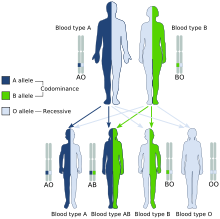Co-dominance can be seen as a relationship between two versions of a gene. Individuals receive a version of a gene, which referred to as an allele, from each parent. When these alleles are different, the dominant allele usually will be expressed, while the impact of the other allele, called recessive, is masked. In co-dominance, nevertheless, neither allele is recessive nor are the pheno types of both alleles expressed. The term co dominance that too explains as the interest between 2 alleles at a locus since animals heterozygous for the 2 alleles shows both the phenotypes seen in animals homozygous for one allele or the other. The prominent example of co-dominance occurs with the A and B alleles at the classical blood type locus (symbolized as I). People heterozygous for the alleles A and B express in both the A and B blood type antigens. These heterozygous individuals are readily distinguishable from both A homozygotes and B homozygotes. The term has coopted by molecular biologists to describe any DNA marker for which alternative alleles can both be readily detected with the use of a DNA-based essay of some kind.

A and B blood types in human exhibit co-dominance, why the O type is recessive to A and B.
Study from the diagram above, it can clarify that in the ABO blood group system, chemical modifications to a glycoprotein (the H antigen) on the surfaces of blood cells are usually controlled by three alleles, in which two are co-dominant to each other (I A , I B ) and dominant over the recessive i at the ABO locus .

The Co-dominance in a Camellia
cultivar
Co-dominance, where allelic products co-exist in the phenotype, is different from incomplete dominance, where the quantitative interaction of allele products produces an intermediate phenotype. For instance, in co-dominance, a red homozygous flower with a white homozygous flower will produce offspring that possess red and white spots. When plants of the F1 generation are self-pollinated, the phenotypic and genotypic ratio of the F2 generation will be 1:2:1 (Red:Spotted: White). These ratios are seen as the same as those for incomplete dominance. Again, note that this classical terminology can be seen as inappropriate – in reality, such cases should not be said to displays dominance at all. From the explanation and analysis, it can be concluded that each individual usually takes one allele from both parents which can be seen.